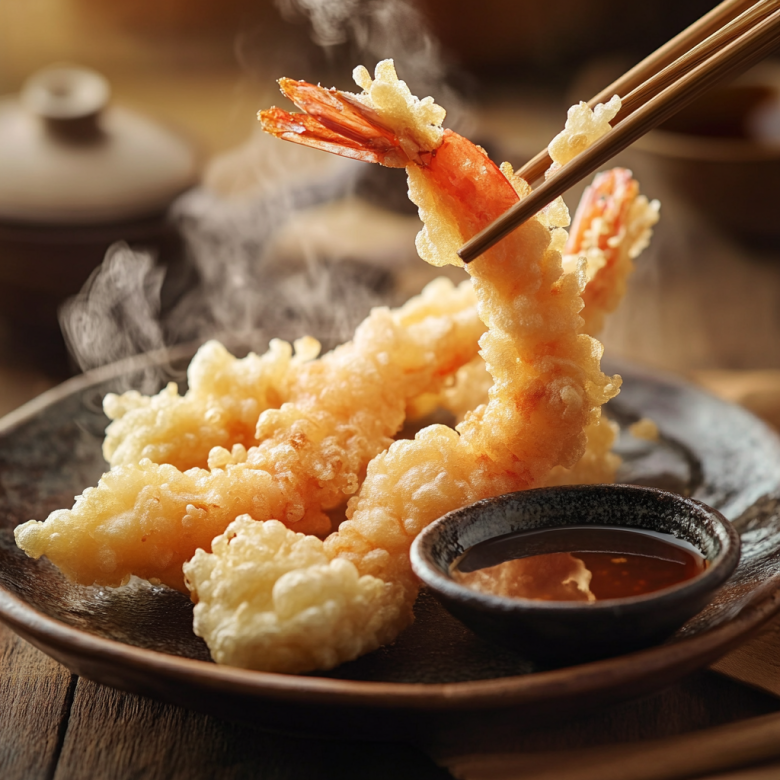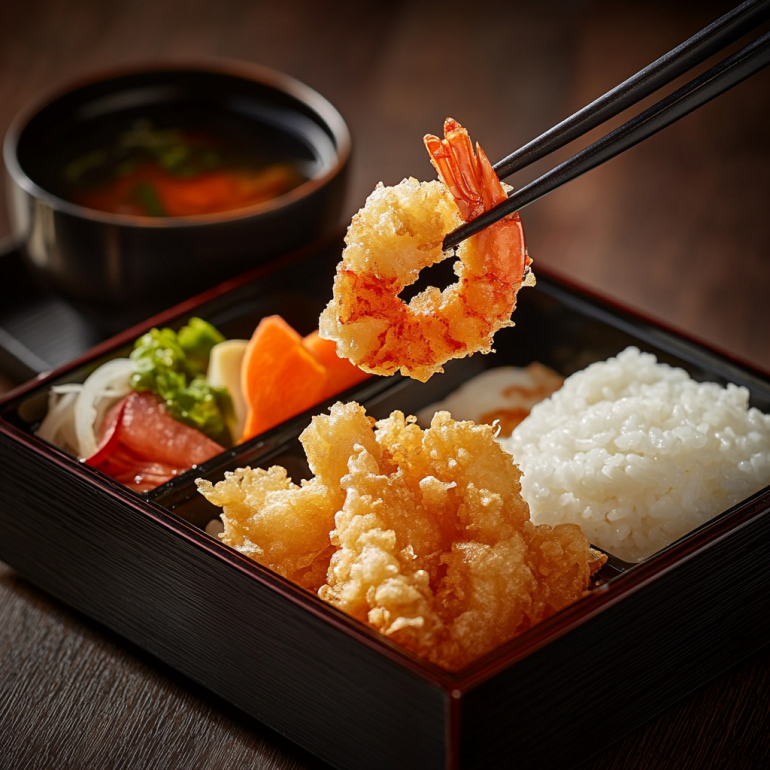Tempura shrimp is a beloved Japanese dish known for its light, crispy texture and delicious flavor. This dish has captivated food enthusiasts worldwide with its perfect blend of tender shrimp and a delicate, airy batter. Let’s dive into the fascinating world of tempura shrimp, exploring its history, preparation techniques, and the best ways to enjoy this culinary delight.
What is Tempura Shrimp?
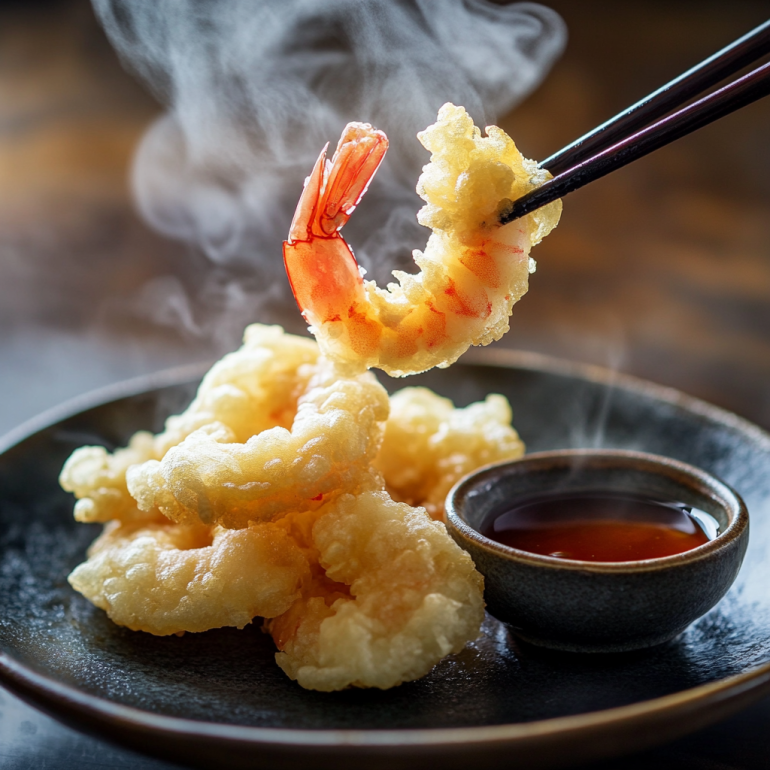
Tempura shrimp is a classic Japanese dish featuring shrimp coated in a light tempura batter and deep-fried to perfection. The key to its appeal lies in the crispy exterior that encases the succulent shrimp within. The dish is often served with a dipping sauce, such as tentsuyu, which complements the flavors beautifully. For those looking to try their hand at making tempura shrimp at home, recipes like the Easy Shrimp Tempura Recipe offer a great starting point.
The tempura batter is typically made from a mixture of flour, cornstarch, and ice-cold water, which helps to achieve the signature crispy texture. The use of cold ingredients is crucial in preventing the formation of gluten, which can make the batter chewy. For a detailed guide on making the perfect tempura batter, check out the Light & Crispy Japanese Shrimp Tempura recipe. You can also explore more about tempura in this comprehensive guide on Japanese Cuisine.
History of Tempura
The origins of tempura can be traced back to the 16th century when Portuguese missionaries introduced the technique of deep-frying to Japan. The Japanese adapted this method, creating a lighter, crispier batter that we now associate with tempura. Over time, tempura has evolved to include a variety of ingredients, but shrimp remains one of the most popular choices. The historical background of tempura adds a layer of intrigue to this already delightful dish. Learn more about the history of tempura on Wikipedia.
Portuguese Influence
The Portuguese influence on Japanese cuisine is particularly notable in the development of tempura. The technique of deep-frying was introduced during the “Ember days,” when Catholics abstained from eating meat. The Portuguese dish “peixinhos da horta,” which consisted of deep-fried green beans, inspired the Japanese to create their own version using various vegetables and seafood. This cultural exchange led to the creation of tempura, which has since become a staple in Japanese cuisine.
Evolution of Tempura
Over the centuries, tempura has evolved to include a wide range of ingredients. While shrimp remains one of the most popular choices, other seafood like squid, scallops, and various types of fish are also commonly used. Vegetables such as sweet potato, eggplant, bell peppers, and mushrooms are also popular tempura ingredients. The versatility of tempura allows for endless combinations and flavors, making it a favorite among food enthusiasts.
Ingredients for Tempura Shrimp
To make tempura shrimp, you’ll need a few essential ingredients:
- Fresh shrimp: The star of the dish, choose large, fresh shrimp for the best results. Ensure the shrimp are deveined and have their shells removed, except for the tail, which adds a nice crunch and visual appeal.
- Tempura batter: Made from flour, cornstarch, and ice-cold water, this batter is the key to achieving the signature crispy texture. The cornstarch helps to reduce gluten formation, keeping the batter light and airy.
- Dipping sauce: Traditionally, tentsuyu sauce is used, but you can also opt for soy sauce or a sweet chili sauce. Tentsuyu is a combination of soy sauce, mirin, and dashi, providing a umami-rich flavor that pairs perfectly with the crispy shrimp.
- Oil for frying: Use a neutral-flavored oil with a high smoke point, such as vegetable or canola oil. The oil should be heated to around 350°F (175°C) to ensure the shrimp cooks evenly and the batter becomes crispy.
Additional Ingredients
While the basic ingredients are essential, you can also experiment with additional flavors:
- Spices: Adding a pinch of paprika, garlic powder, or onion powder to the batter can enhance the flavor profile of your tempura shrimp.
- Herbs: Incorporating fresh herbs like parsley or chives into the batter or as a garnish can add a fresh, aromatic touch.
- Citrus: A squeeze of lemon or lime juice over the fried shrimp can brighten the flavors and cut through the richness of the fried batter.
Preparation Techniques
Preparing tempura shrimp involves several steps to ensure the perfect texture and flavor:
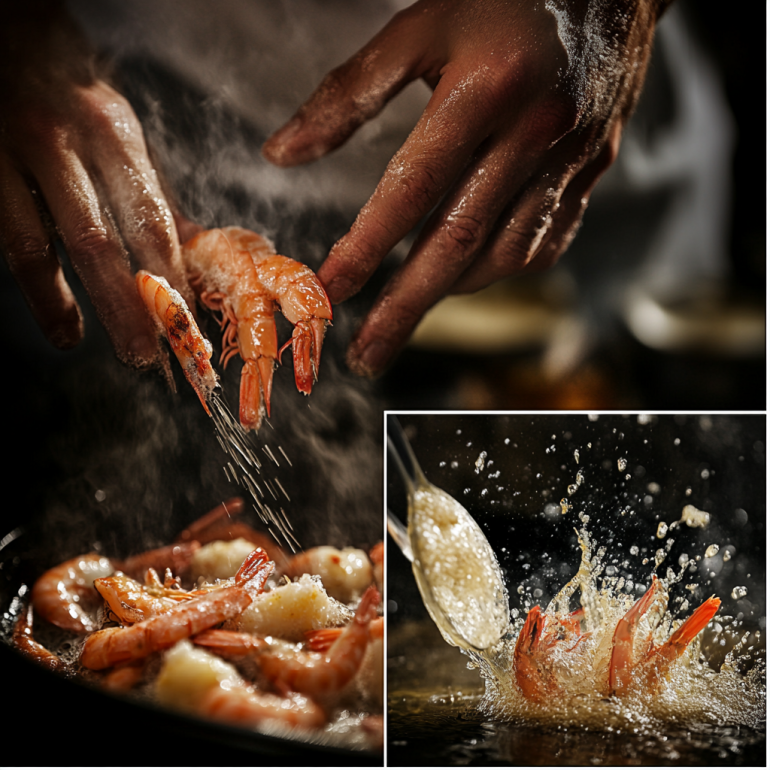
- Prepare the shrimp: Remove the shell and devein the shrimp. Make small incisions on the belly side to prevent curling during frying. This step is crucial for achieving a straight, aesthetically pleasing shape.
- Make the batter: Combine flour, cornstarch, and ice-cold water. Avoid overmixing to minimize gluten formation, which can make the batter chewy. The batter should be light and runny, coating the shrimp evenly without being too thick.
- Coat the shrimp: Dip the shrimp in the batter, ensuring they are fully coated. Allow any excess batter to drip off to prevent soggy tempura.
- Fry the shrimp: Heat the oil to the optimal temperature (around 350°F or 175°C) and fry the shrimp in batches until golden brown and crispy. Overcrowding the pot can lower the oil temperature, leading to soggy tempura, so fry in small batches.
Tips for Perfect Tempura
- Cold ingredients: Keep your batter ingredients cold to minimize gluten formation. Using ice-cold water and even chilling the flour can help achieve a lighter, crispier texture.
- Rest the batter: Letting the batter rest for a few minutes before using it can help the ingredients meld together, resulting in a smoother coating.
- Double-fry method: For extra crispy tempura, you can use the double-fry method. Fry the shrimp briefly at a lower temperature (around 320°F or 160°C) to cook the interior, then increase the temperature to 350°F (175°C) to achieve a golden, crispy exterior.
Cooking Tempura Shrimp
Cooking tempura shrimp requires careful attention to detail:
- Temperature control: Maintain a consistent oil temperature to ensure even cooking and a crispy exterior. Using a deep-fry thermometer can help you monitor the temperature accurately.
- Avoid overcrowding: Fry the shrimp in small batches to prevent the oil temperature from dropping and to ensure even cooking. Overcrowding can lead to uneven cooking and soggy tempura.
- Drain excess oil: After frying, drain the shrimp on paper towels to remove excess oil and maintain crispiness. Allowing the shrimp to rest on a wire rack can also help keep them crispy by preventing steam from softening the batter.
Common Mistakes to Avoid
- Overmixing the batter: Mixing the batter too vigorously can develop gluten, making the tempura chewy instead of crispy.
- Not chilling the ingredients: Warm ingredients can lead to a denser, less crispy batter. Keep everything cold until ready to fry.
- Using the wrong oil: Choosing an oil with a low smoke point can result in burnt tempura and an unpleasant taste. Stick to neutral-flavored oils with high smoke points.
Serving Suggestions
Tempura shrimp can be enjoyed in various ways:
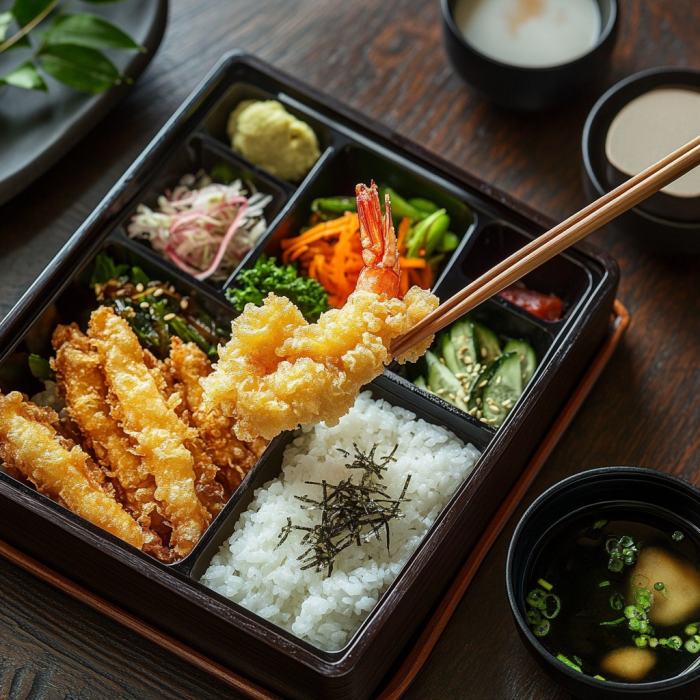
- As an appetizer: Serve with a dipping sauce for a delightful starter. The classic tentsuyu sauce is a perfect accompaniment, but you can also use soy sauce, sweet chili sauce, or even a spicy mayo.
- With rice or noodles: Pair with steamed rice or udon noodles for a satisfying meal. The crispy shrimp adds a lovely texture contrast to the soft rice or chewy noodles.
- In sushi rolls: Add crispy shrimp tempura to your favorite sushi rolls for added texture and flavor. Tempura shrimp rolls are a popular choice in many sushi restaurants.
- With vegetables: Serve tempura shrimp alongside tempura vegetables like sweet potato, bell peppers, and zucchini for a varied and colorful meal.
Creative Serving Ideas
- Tempura shrimp tacos: Use the crispy shrimp as a filling for tacos, topped with shredded cabbage, avocado, and a drizzle of spicy mayo or sriracha.
- Tempura shrimp salad: Toss the fried shrimp with mixed greens, cherry tomatoes, cucumber, and your favorite vinaigrette for a refreshing and hearty salad.
- Tempura shrimp po’ boy: Create a Japanese-inspired po’ boy sandwich by stuffing a baguette with tempura shrimp, shredded lettuce, tomato slices, and a creamy remoulade sauce.
Variations of Tempura Shrimp
Tempura shrimp has inspired numerous variations:
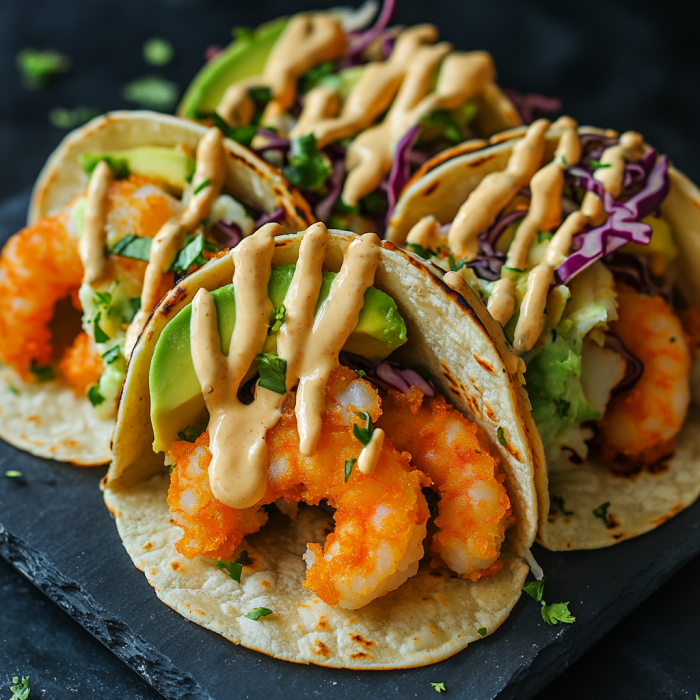
- Regional variations: Different regions in Japan have their own take on tempura, with some preferring a lighter batter or different dipping sauces. In the Kanto region, for example, the batter tends to be lighter and crispier, while in the Kansai region, a slightly thicker batter is preferred.
- Fusion recipes: Creative twists on tempura shrimp include adding spices to the batter or serving with non-traditional sauces. Some recipes incorporate curry powder, chili flakes, or even matcha powder for a unique flavor profile.
- International Influences:
- Korean-style tempura: Incorporate gochujang, a Korean chili paste, into the batter or dipping sauce for a spicy kick.
- Thai-inspired tempura: Add lemongrass, kaffir lime leaves, and Thai chili peppers to the batter for a fragrant, Southeast Asian twist.
- Mexican fusion: Serve tempura shrimp with a creamy avocado sauce, fresh salsa, and a sprinkle of cotija cheese for a Mexican-inspired dish.
Tempura Shrimp in Popular Culture
Tempura shrimp has made appearances in various forms of media, from anime to cookbooks, showcasing its popularity and influence on global cuisine. Its presence in popular culture has further cemented its status as a beloved dish. For more insights, explore The Cultural Significance of Tempura.
Anime and Manga
In Japanese anime and manga, tempura shrimp is often depicted as a comforting and delicious meal. Characters are frequently shown enjoying tempura at izakayas (Japanese pubs) or during festivals, highlighting its significance in Japanese food culture.
Cookbooks and TV Shows
Tempura shrimp recipes are a staple in many Japanese cookbooks and have been featured on numerous cooking shows. Celebrity chefs often demonstrate their own takes on tempura, showcasing the dish’s versatility and appeal. Check out this Tempura Recipe by Jamie Oliver for a professional twist.
Making Tempura Shrimp at Home
Making tempura shrimp at home can be a rewarding experience:
- Tips and tricks: Use ice-cold water for the batter and avoid overmixing. Fry in small batches and maintain a consistent oil temperature. Keep the batter ingredients cold until ready to use.
- Essential tools: A deep fryer or a deep pot for frying, a thermometer for monitoring oil temperature, and a slotted spoon for removing the shrimp from the oil. A wire rack is also useful for draining excess oil and keeping the tempura crispy.
- Step-by-Step Guide:
- Prepare the shrimp: Devein and remove the shell from the shrimp, leaving the tail intact. Make small incisions on the belly side and straighten the shrimp.
- Make the batter: Combine flour, cornstarch, and ice-cold water. Mix gently to avoid forming gluten.
- Coat the shrimp: Dip each shrimp into the batter, ensuring it is fully coated. Allow excess batter to drip off.
- Fry the shrimp: Heat oil to 350°F (175°C) and fry the shrimp in batches for about 2-3 minutes on each side, or until golden brown and crispy.
- Drain and serve: Remove the fried shrimp from the oil using a slotted spoon and drain on paper towels or a wire rack. Serve immediately with your preferred dipping sauce.
Tempura Shrimp in Restaurants
Tempura shrimp is a staple in Japanese restaurants worldwide:
- Restaurant-quality tempura: Restaurants often use specialized equipment and techniques to achieve the perfect crispy texture. Professional fryers with precise temperature control and high-quality oils contribute to the superior texture of restaurant tempura.
- Differences from homemade: Restaurant tempura may have a lighter, crispier batter due to professional frying techniques and freshly made batter. The use of specialized ingredients and expert cooking methods can result in a more refined taste and texture.
Finding the Best Tempura
Look for freshness: The best tempura is made with fresh, high-quality ingredients. Ensure the shrimp is fresh and the oil is clean and hot.
- Observe the batter: A light, airy batter that is not too thick or soggy is a sign of well-made tempura. The tempura should have a delicate, lacy texture.
- Check the oil: Clean, hot oil is essential for crispy tempura. If the oil is dirty or not hot enough, the tempura will be soggy and greasy.
Nutritional Information
Tempura shrimp is an indulgent treat, but it’s important to consider its nutritional value:
- Calories: A typical serving of tempura shrimp can range from 200 to 300 calories, depending on the portion size and cooking method. The calorie count can vary based on the amount of batter and oil absorbed during frying.
- Protein: Shrimp is a good source of protein, essential for muscle repair and growth. A serving of tempura shrimp can provide around 20-25 grams of protein.
- Fat: Deep-frying adds fat to the dish, so enjoy in moderation as part of a balanced diet. The fat content can vary based on the type of oil used and the frying technique.
- Carbohydrates: The tempura batter contributes to the carbohydrate content, which can range from 15-20 grams per serving. The exact amount depends on the thickness of the batter and the amount absorbed by the shrimp.
Healthier Alternatives
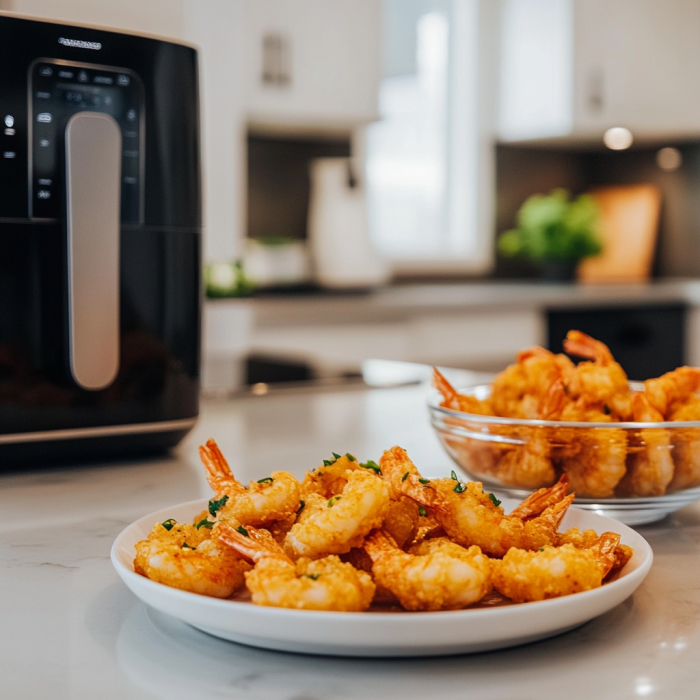
- Baking: While baking can be a healthier option, it may not achieve the same crispy texture as deep-frying. For a healthier version, try coating the shrimp in a thin layer of batter and baking at a high temperature until crispy.
- Air-frying: Using an air fryer can help reduce the amount of oil absorbed by the shrimp, resulting in a healthier tempura. Preheat the air fryer to 375°F (190°C) and cook the battered shrimp for about 5-7 minutes on each side.
FAQs
-
What is the best type of shrimp for tempura? Large, fresh shrimp are ideal for tempura shrimp. Choose shrimp that are firm and have a mild ocean scent. Tiger shrimp or white shrimp are popular choices due to their size and flavor.
-
How do you prevent the shrimp from curling during frying? Make small incisions on the belly side of the shrimp and straighten them before coating in batter. This helps to release tension in the shrimp, preventing them from curling during frying.
-
Can you bake tempura shrimp instead of frying? While baking can be a healthier option, it may not achieve the same crispy texture as deep-frying. For best results, stick to frying or use an air fryer for a healthier alternative.
-
What is the difference between tempura and panko breading? Tempura batter is lighter and crispier, while panko breading is made from breadcrumbs and has a different texture and flavor. Tempura batter is typically made from flour and cornstarch, resulting in a delicate, airy coating. Panko breading, on the other hand, provides a crunchier, more robust texture.
-
How do you make tempura dipping sauce? Tempura dipping sauce, or tentsuyu, is made from soy sauce, mirin, and dashi. It can be purchased pre-made or made at home by combining equal parts soy sauce and mirin with a small amount of dashi. Heat the mixture gently and let it cool before serving.
-
Can you reuse tempura batter? Tempura batter should be used immediately after mixing for the best results. If the batter sits for too long, the gluten in the flour will develop, resulting in a chewy, less crispy coating. It’s best to mix the batter right before frying and use it promptly.
-
How do you store leftover tempura shrimp? Leftover tempura shrimp can be stored in an airtight container in the refrigerator for up to 3 days. To reheat, place the shrimp on a baking sheet and bake at 350°F (175°C) for about 10-15 minutes, or until crispy. Avoid reheating in the microwave, as this can make the tempura soggy.
-
Can you freeze tempura shrimp? Tempura shrimp can be frozen for up to 2 months. To freeze, place the cooked and cooled shrimp in a single layer on a baking sheet and freeze until solid. Transfer the frozen shrimp to an airtight container or freezer bag. To reheat, bake the frozen shrimp at 375°F (190°C) for about 15-20 minutes, or until crispy.
Conclusion
Tempura shrimp is a delightful dish that combines the best of Japanese culinary techniques with fresh, succulent shrimp. Whether enjoyed as an appetizer or part of a larger meal, its crispy texture and delicious flavor make it a favorite among food enthusiasts. With a bit of practice, you can master the art of making tempura shrimp at home and impress your friends and family with this classic Japanese dish. By following the tips and tricks outlined above, you can create a restaurant-quality dish in the comfort of your own home, making every bite a crispy, satisfying experience.
